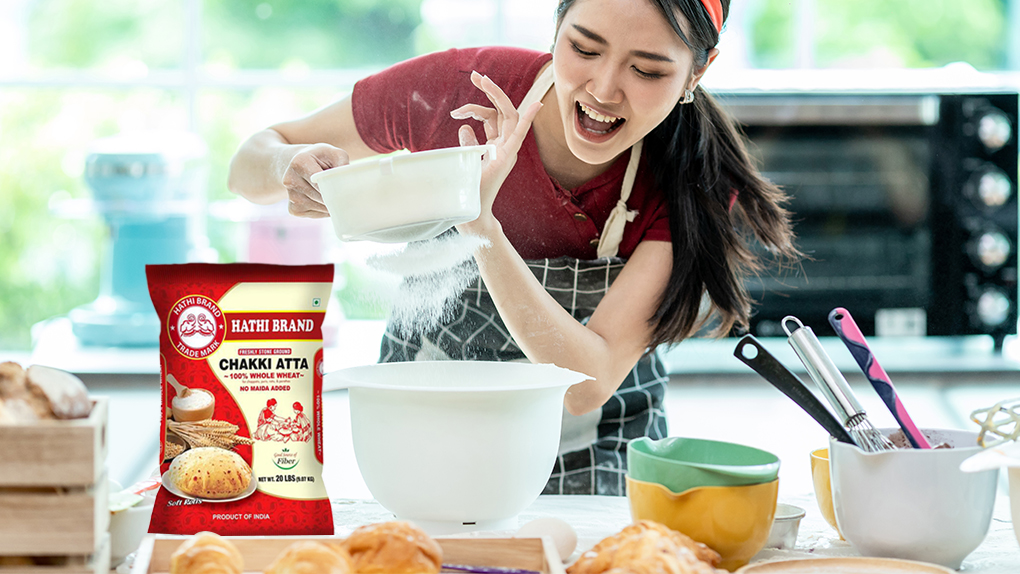From ancient grains to the heart of modern kitchens, whole wheat atta has a fascinating history. Einkorn and emmer were ancient grains ground by hand using stone tools. Our ancestors recognized the nutritional value and versatile nature of these grains. Fast forward to today, and whole wheat atta remains a beloved staple, seamlessly fitting into the hustle and bustle of modern kitchens. Whole wheat atta has traveled through time, gracing the tables of both royalty and common folk. In ancient civilizations, wheat was cherished for its ability to nourish and sustain. As the milling methods advanced, making whole wheat atta became more refined, leading to the high-quality flour we enjoy today. Hathi Brand carries forward this rich legacy, bringing the wholesome goodness of ancient wheat to today’s homes with our 100% Whole Wheat Chakki Atta. Discover the history of whole wheat atta, from its ancient origins to its place in modern cuisine, with this article.
Ever wonder how the humble whole wheat atta became a staple in your modern kitchen? What if we told you that the story of this versatile flour spans thousands of years, from the fields of ancient civilizations to the shelves of contemporary grocery stores?
Let’s understand the historical journey of exploring the origins and evolution of whole wheat atta.
Ancient Grains to Modern Kitchens
Wheat has been the foundation of human diets for millennia. Long before it became the all-purpose flour we know today, wheat’s ancient counterparts, einkorn, and emmer, were the popular grains back then. The stone-ground flour of these grains was the earliest form of whole wheat atta. This flour was a symbol of sustenance and energy, enjoyed by ancient civilizations for its nutritional value and versatility.
Nutritional Value of Wheat: The Plant Structure
Wheat, in its whole form, is a powerhouse of nutrition. The wheat grain comprises three essential parts: the bran, germ, and endosperm. Whole wheat atta retains all three parts, making it more nutritious than refined flour.
- Bran: The outer layer contains fiber, antioxidants, and B vitamins.
- Germ: The nutrient-packed core containing healthy fats, vitamin E, and essential fatty acids.
- Endosperm: The starchy middle layer provides carbohydrates and protein.
The nutritional value of whole wheat atta is impressive. It is a rich source of dietary fiber, which helps boost digestion and maintain healthy cholesterol levels. It also provides essential vitamins and minerals like iron, magnesium, and zinc, which are necessary for various bodily functions. Whole wheat atta stands out for its comprehensive nutrient profile compared to treated wheat and rising flour.
The Evolution and Use of Whole Wheat Grains Throughout History
The history of wheat flour depicts human innovation and adaptability. Ancient grains like einkorn and emmer were domesticated around 10,000 years ago in the Fertile Crescent. These grains were hardy and nutritious, well-suited to the agricultural practices of early farmers.
Cultivation and refinement grew with civilization. Ancient Egyptians revered wheat so highly that they buried it with pharaohs for the afterlife. The Greeks and Romans advanced milling techniques, producing finer and more diverse wheat products.
Throughout history, the process of making whole wheat atta has evolved. Traditional stone grinding (chakki) methods preserved the integrity of the grain, ensuring that all nutritional components were retained. This organic milling process contrasted sharply with modern wheat refining techniques, which often strip away the most nutritious parts of the grain.
Wheat in Modern Cuisine: Versatility and Popularity
Whole wheat atta has found a permanent place in the hustle and bustle of the modern kitchen. Its versatility makes it a favorite among first-time home bakers and professional chefs. From rotis and parathas in Indian households to whole grain bread and pasta in Western cuisines, whole wheat atta is used for its rich flavor and health benefits.
Whole wheat atta is used in everything from traditional recipes to innovative dishes. It is used to bake cakes, cookies, and even pizza dough. The rise of health-conscious eating has further boosted the popularity of whole wheat atta, as people choose whole grain foods for their dietary benefits.
Hathi Brand 100% Whole Wheat Chakki Atta: A Legacy of Quality
At Hathi Brand, we proudly carry the rich legacy of whole wheat atta. Our 100% Whole Wheat Chakki Atta is made using traditional stone grinding methods, ensuring that all the goodness of ancient grains of wheat is retained.
Why choose Hathi Brand?
- Nutritional Integrity: Our atta retains the bran, germ, and endosperm, offering complete nutrition.
- Superior Taste: The natural flavors of ancient wheat make every dish more wholesome and delicious.
- Quality Assurance: We follow the highest quality control steps to ensure that every pack of Hathi Brand atta meets our high standards.
Using Hathi Brand 100% Whole Wheat Chakki Atta in your diet means choosing a product rooted in history and enhanced for the modern kitchen. It is perfect for traditional recipes and modern culinary experiments alike.
Conclusion
The historical journey of whole wheat atta is an interesting story of evolution and adaptation. From the fields of ancient civilizations to today’s kitchens, whole wheat atta has remained a staple, cherished for its nutritional benefits and versatility.


